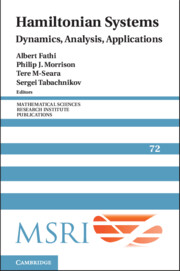Book contents
- Frontmatter
- Contents
- Denjoy subsystems and horseshoes
- Impact Hamiltonian systems and polygonal billiards
- Some remarks on the classical KAM theorem, following Pöschel
- Some recent developments in Arnold diffusion
- Viscosity solutions of the Hamilton–Jacobi equation on a noncompact manifold
- Holonomy and vortex structures in quantum hydrodynamics
- Surfaces of locally minimal flux
- A symplectic approach to Arnold diffusion problems
- Hamiltonian ODE, homogenization, and symplectic topology
Viscosity solutions of the Hamilton–Jacobi equation on a noncompact manifold
Published online by Cambridge University Press: 10 May 2024
- Frontmatter
- Contents
- Denjoy subsystems and horseshoes
- Impact Hamiltonian systems and polygonal billiards
- Some remarks on the classical KAM theorem, following Pöschel
- Some recent developments in Arnold diffusion
- Viscosity solutions of the Hamilton–Jacobi equation on a noncompact manifold
- Holonomy and vortex structures in quantum hydrodynamics
- Surfaces of locally minimal flux
- A symplectic approach to Arnold diffusion problems
- Hamiltonian ODE, homogenization, and symplectic topology
Summary
This work was started in February 2017 in Rome, following a conversation with Piermarco Cannarsa, Andrea Davini, Antonio Siconolfi and Afonso Sorrentino. We discussed the problem of the Lax–Oleinik evolution û (see Definition 8.2) of a continuous function u on a noncompact manifold. Although on a compact manifold, it was known that the Lax–Oleinik evolution of a continuous function is always locally concave and a solution of the Hamilton–Jacobi equation in evolution form, at that moment, the situation on a noncompact manifold was not clear, even assuming the continuity of the Lax–Oleinik evolution. The main problem was that it was not clear that the inf in Definition 8.2 of û was attained. After about a month, to my astonishment, I realized that no condition beyond finiteness was necessary; see Theorem 1.1.
This brought back the problem of uniqueness of a solution of the Hamilton–Jacobi equation in evolution form given an initial condition. In May 2016 in Shanghai, KaizhiWang, LinWang and Jun Yan, while discussing [11], brought to my attention that, contrary to my belief, the uniqueness of a continuous solution of the Hamilton–Jacobi equation in evolution form given an initial condition on a noncompact manifold was not known at that time (and therefore the Lax–Oleinik formula could not be established) unless the solution was uniformly continuous. The best results on this problem were those contained, for example, in Hitoshi Ishii’s lecture notes [10], on whose methods this present work heavily relies. The difficulty here is that the maximum principle could not be applied directly, since it requires some compactness. In 2018 and 2019, I was able to show directly the Lax–Oleinik formula for arbitrary continuous solutions (see Theorem 1.2) and therefore I obtained the uniqueness as a consequence.
Information
- Type
- Chapter
- Information
- Hamiltonian SystemsDynamics, Analysis, Applications, pp. 111 - 172Publisher: Cambridge University PressPrint publication year: 2024
Accessibility standard: Unknown
Why this information is here
This section outlines the accessibility features of this content - including support for screen readers, full keyboard navigation and high-contrast display options. This may not be relevant for you.Accessibility Information
- 1
- Cited by
